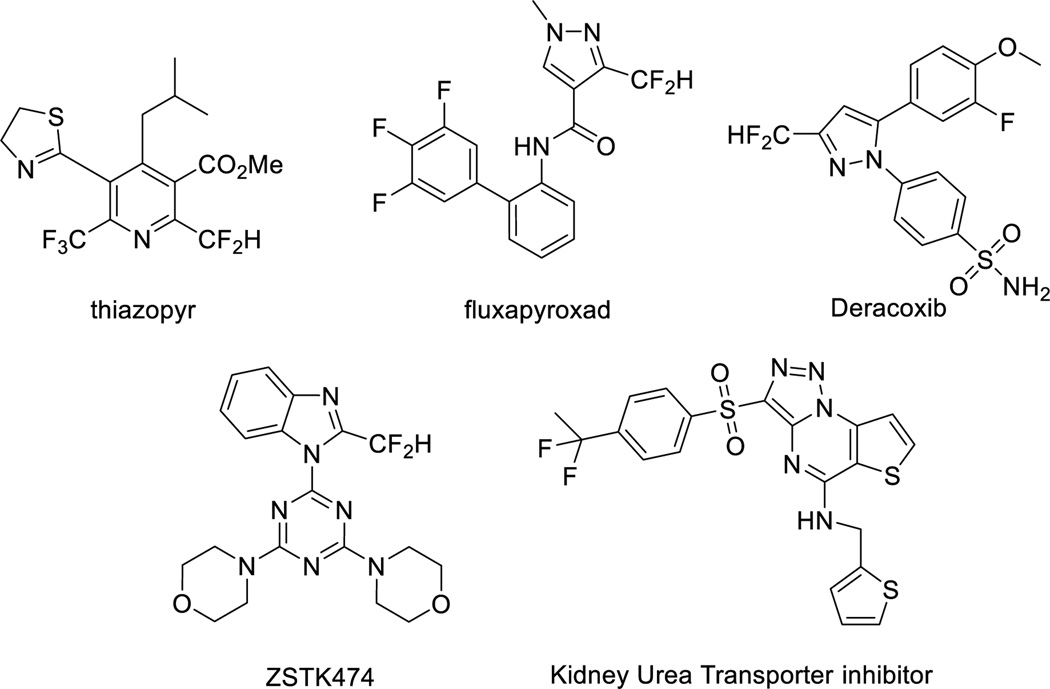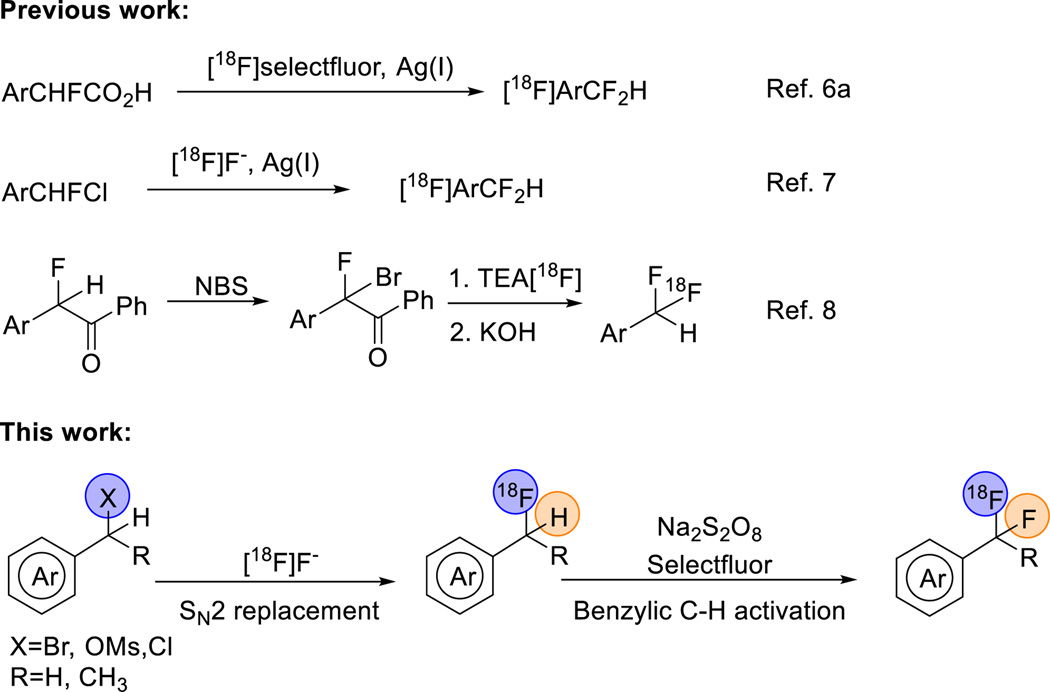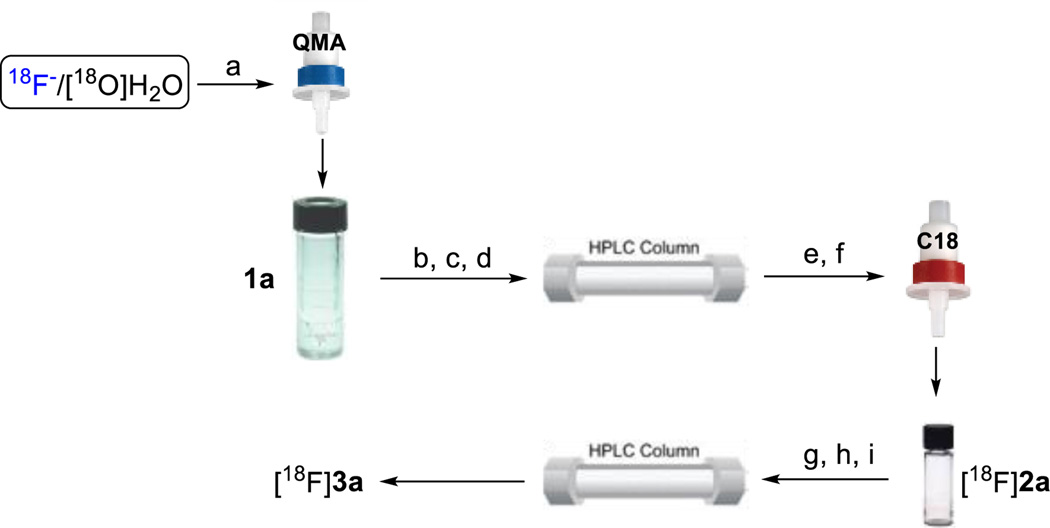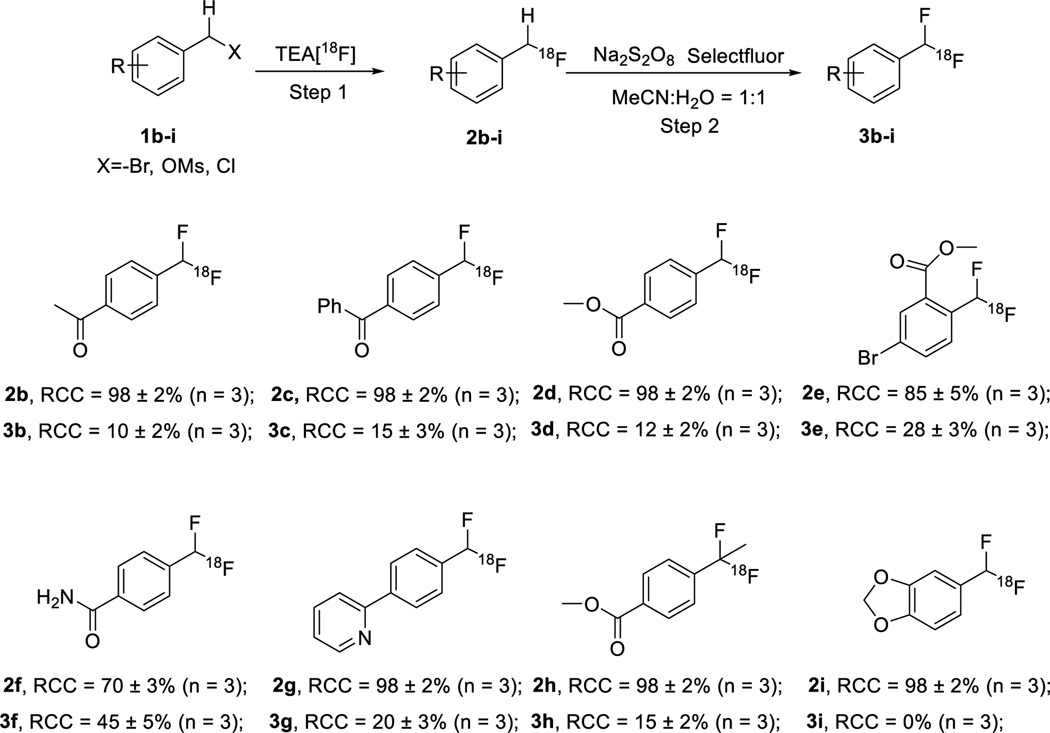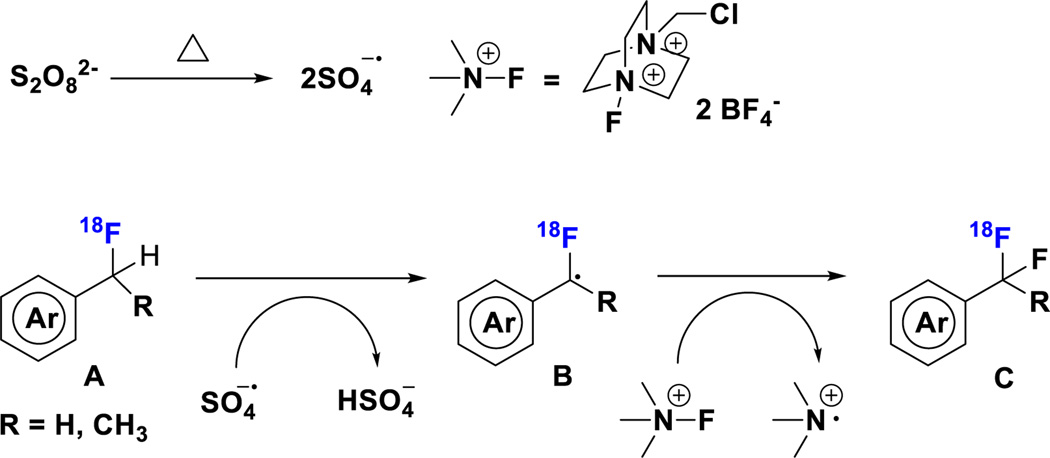Abstract
A metal-free and selective method to form [18F]aryl-CF2H through a nucleophilic radiofluorination of benzyl (pseudo)halides and oxidative C-H activation of a benzylic C–H bond has been developed. The method is operationally simple and tolerates a variety of electron-neutral/deficient arenes and heteroarenes.
Fluorine bearing functionalities are found in a wide range of materials and biologically active molecules.1 Incorporation of the fluorine-18 radionuclide into these molecules facilitates the application of noninvasive positron emission tomography (PET) imaging in quantifying biochemical and pharmacological processes. As a result, continuous efforts have been made to develop novel radiofluorination methods that provide a diverse range of 18F-labeled vectors to support molecular imaging research and drug discovery.2 Isosteristic replacement of the phenolic hydroxyl group with aromatic difluoromethyl functionality (Ar-CF2H) has been demonstrated as a useful medicinal chemistry approach, leading to discovery of bioactive molecules, including thiazopyr, fluxapyroxad, deracoxib, ZSTK474 etc (Scheme 1).1d, 3
Scheme 1.
Aryl-CF2H containing bioactive molecules.
The success of this substitution has been attributed to the similar acidic and isopolar characteristics of CF2H and OH. Moreover, the CF2H functionality features comparable hydrogen-bond-donating capability to that of OH and NH groups, but much reduced hydrophilicity.4 Compared with recent advances in the preparation of non-radioactive Ar-CF2H,5 18F-labeling of this group has not yet been fully exploited. Initial methods relied on the silver(I)-mediated fluorodecarboxylation of α-fluorarylacetic acids with [18F]Selectfluor bis(triflate), an electrophilic fluorinating reagent derived from [18F]F2.6 An alternative 18F-incorporation method employed a silver(I)-mediated halogen exchange strategy with readily available [18F]fluoride under mild reaction conditions, but required aryl-CHFCl precursors prepared by multi-step synthesis.7 Our recent work disclosed a more practical method, starting from easily accessed aryl (pseudo)halides, via the activation of a benzoyl auxiliary, to form the [18F]Ar–CF2H functionality with an excellent substrate scope.8 However, to date, syntheses of [18F]aryl-CF2H has resulted in low-to-moderate specific activity radiotracers, which may have limited their application in PET imaging studies, particularly for low density biological targets.
Recently we demonstrated the capability of silver-catalyzed oxidative activation of benzylic C-H bonds of aryl-CH3 for the synthesis of aryl-CF2H, and which was further adapted to transition-metal-free conditions.9 Inspired by these discoveries, we speculated that a similar protocol could be applicable to the transformation of benzylic C–H to C–18F bond formation in the context of [18F]aryl-CFH2 intermediates, which could be easily obtained via nucleophilic radiofluorination of the benzyl-(pseudo)halides with [18F]fluoride (Scheme 2). Herein we report a general and metal-free method to radiolabel [18F]aryl-CF2H groups via a sequential nucleophilic radiofluorination of benzyl (pseudo)halides, followed by oxidative C-H activation.
Scheme 2.
Radiolabeling of [18F]aryl-CF2H.
The feasibility of our method was experimentally confirmed, and further optimized by the radiosynthesis of 4-([18F]difluoromethyl)-1,1'-biphenyl ([18F]3a). An illustrative workflow is depicted in Scheme 3. Near quantitative radiochemical conversion (RCC; 98 ± 2%, n > 10) of 1a (8.09 µmol) to [18F]2a was achieved in 10 min in MeCN with tetraethylammonium bicarbonate (TEAB, 10.4 µmol) at 130 °C (Table 1). Under these conditions, the milder base used herein, compared with tetra-n-butylammonium hydroxide (TBAH),10 resulted in a 2-fold increase in RCC. Isolated [18F]2a was subsequently applied to oxidative reaction conditions to install the benzyl 18F-fluoride. This step was optimized by varying the temperature and stoichimetry of reagents including AgNO3, Na2S2O8, and Selectfluor (Table 2). Under the initial optimal reaction conditions (Table 2, entry 3, RCC = 41 ± 6%), removal of AgNO3 gave superior RCC (50 ± 5%, entry 7), indicating such C-H activation can be achieved under transition-metal-free conditions.9b Finally, compound [18F]3a was obtained in 50 ± 5% RCC with Na2S2O8 (33.6 µmol), Selectfluor (56.5 µmol) at 120 °C for 10 min (Table 2, entry 7).
Scheme 3.
Synthesis of [18F]2a and [18F]3a. Synthesis of [18F]2a: (a) trap and release 18F− into V-vial via a solution of TEAB in 1 mL MeCN/H2O (v/v 7:3); (b) azeotropic drying with anhydrous MeCN (3 × 1 mL, 3 min for each cycle); (c) addition of 1a, MeCN, 130°C, 10 min; (d) dilution and subsequent purification of the reaction mixture (~12 min); (e) concentration of the eluent via C18 cartridge (~2 min); (f) release of [18F]2a via 1 mL MeCN(~1 min). Synthesis of [18F]3a: (g) addition of Na2S2O8, Selectfluor and EtOH(~1 min); (h) 120°C, 10 min; (i) dilution and subsequent purification of the reaction mixture (~12 min).
Table 1.
Optimization for the synthesis of 4-([18F]fluoromethyl)-1,1'-biphenyl ([18F]2a)
 | |||||
|---|---|---|---|---|---|
| Entry | 1a (mg) | Base (mg) | Time (min) | Temp. (°C) | 2a RCC (%)a |
| 1 | 2.0 | TBAH (3.1) | 10 | 130 | 49 ± 3 (n = 2) |
| 2 | 2.0 | TEAB (0.5) | 10 | 130 | 50 ± 2 (n = 2) |
| 3 | 2.0 | TEAB (1.0) | 10 | 130 | 85 ± 1 (n = 2) |
| 4 | 2.0 | TEAB (2.0) | 10 | 130 | 98 ± 2 (n > 10%) |
Determined by radio-TLC integration.
Table 2.
Optimization for the preparation of 4-([18F]difluoromethyl)-1,1'-biphenyl ([18F]3a)
 | ||||||
|---|---|---|---|---|---|---|
| Entry | AgNO3 (mg) | Na2S2O8 (mg) | selectfluor (mg) | Time (min) | Temp. (°C) | RCC (%)a |
| 1 | 8.0 | 4.0 | 20.0 | 10 | 120 | 20 ± 2 (n = 2) |
| 2 | 4.0 | 4.0 | 20.0 | 10 | 120 | 38 ± 5 (n = 2) |
| 3 | 4.0 | 8.0 | 20.0 | 10 | 120 | 41 ± 6 (n = 2) |
| 4 | 4.0 | 12.0 | 20.0 | 10 | 120 | 23 ± 3 (n= 2) |
| 5 | 4.0 | 8.0 | 5.0 | 10 | 120 | 0 (n= 2) |
| 6 | 4.0 | 8.0 | 15.0 | 10 | 120 | 33 ± 3 (n= 2) |
| 7 | 0.0 | 8.0 | 20.0 | 10 | 120 | 50 ± 5 (n= 3) |
Determined by radio-HPLC integration of product peaks, relative to [18F]fluoride and 18F-side products.
The scope of this methodology was then explored with more challenging substrates (Scheme 4). Under the optimized reaction conditions, all 18F-monofluorinated products were synthesized quantitatively, except [18F]2e (85 ± 5%) and [18F]2f (70 ± 3%). The isolated 18F-labeled compounds ([18F]2b–2i) were then subjected to the second step under optimized reaction conditions as described above. The final products [18F]3b–3h were obtained with moderate-to-good RCCs, ranging from 10% to 45%. As shown in Scheme 4, para-substituted electron-deficient ketone substrates [18F]2b and [18F]2c gave 10% and 15% RCCs, respectively. Ester substitution in the para-position of [18F]2d also yielded 12% RCC. Substrate [18F]2e exemplified the applicability of this method for a multi-substituted, sterically hindered compound with 28% RCC. In addition, bromide motif in the product [18F]3e could allow further coupling reactions with various counterparts to provide more complex molecules. This method was also found to give good conversion for substrate [18F]2f (RCC = 45%) possessing a primary amide. The success of 2-arylpyridine substrate [18F]2g showed compatibility of this labeling strategy for N-heteroatom bearing compounds. It is also noteworthy that substrate [18F]2h, demonstrated the introduction of a second fluorine atom onto a tertiary carbon. Furthermore, product [18F]3h, bearing (1,1-difluoroethyl)benzene fragment, is a key structural motif in a series of potent kidney urea transporter inhibitors,11 analogous to the compound shown in Scheme 1. The electron-rich arene 1i led to no desired product [18F]3i, as [18F]2i immediately decomposed to [18F]fluoride under our standard oxidative conditions as well as alternative oxidation reagents, for example 1-chloromethyl-4-fluoro-1, 4-diazoniabicyclo [2.2.2] octane bis(hexafluorophosphate) (F-TEDA-PF6).12 It is possible that the increased reactivity brought by the electron donating groups make [18F]2i more vulnerable to the fluorinating reagents and/or radical defluorination.
Scheme 4.
Scope of the oxidative benzylic C-H activation in preparing the [18F]aryl-CF2H products.
A plausible reaction mechanism is shown in Scheme 5. Homolytic cleavage of a peroxydisulfate anion produces two sulfate radical anions at elevated temperature, which oxidizes the benzylic C-H bond of [18F]aryl-CFH2 (A) to a benzylic radical (B). Then, Selectfluor, reacts through a radical mechanism,13 providing a fluorine radical for bond formation with benzylic radical (B) to produce the desired [18F]aryl-CF2H (C).
Scheme 5.
Proposed mechanism for the radiosynthesis of [18F]aryl-CF2H.
Specific activity is a very critical parameter which should be considered in both radiolabeling methods and PET imaging studies.14 Obtaining high specific activity is an ongoing challenge for many 18F-labeling of multi-fluorinated compounds.6a,7,8 As shown in Scheme 6, we measured the specific activity of aryl-CF2H product [18F]3a by our protocol (see SI for details). Briefly, compound [18F]2a was synthesized and isolated using a commercial automated radiofluorination unit (GE TRACERlab™ FXFN; Figure S1, SI), starting from 1.7 GBq of [18F]fluoride, in 61% radiochemical yield (non-decay corrected) with >99% radiochemical purity and 51.8 GBq/µmol specific activity at the end-of-synthesis (~60 min synthesis time from [18F]fluoride). The isolated intermediate [18F]2a was formulated and eluted from C-18 cartridge with 1 mL of MeCN. The activity was diluted with 1 mL of sterile water, from which 0.4 mL was used for the second step. Under the optimized conditions, the mixture was heated for 10 min, cooled and diluted with mobile phase. The reaction mixture was injected into semi-preparative HPLC for purification. The purified [18F]3a was isolated in 38% radiochemical yield (non-decay corrected, based on the added activity of [18F]2a) with specific activity of 22.2 GBq/µmol at end-of-synthesis (~25 min synthesis time from the addition of [18F]2a). As shown in Table 3, the current method gives superior specific activity among other reported synthesis of [18F]aryl-CF2H.6a,7,8 Efforts were also made to further improve the specific activity by changing the counterion of the current fluorinating reagents to PF6− (F-TEDA-PF6) and OTf− (1-chloromethyl-4-fluoro-1,4-diazoniabicyclo [2.2.2]octane bis(trifluoromethane sulfonate; F-TEDA-OTf; see SI for its preparation), though none of them gave the desired product [18F]3a. Since the tetrafluoroborate anion (BF4−) had been proven to give comparably high specific activity as that of OTf− in an analogous radiosynthesis of aryl-[18F]fluoride from (mesityl)(aryl)iodonium salt precursors,15 it is reasonable to postulate there was limited exchange reactions between 19F and 18F during the present radiolabeling conditions.
Scheme 6.
Specific activity determination for 4-([18F]difluoromethyl)-1,1'-biphenyl([18F]3a).
Table 3.
Summary of the radiolabeling of [18F]aryl-CF2H
| Ref. | [18F]aryl-CF2H | Reaction type | Starting radioactivity | Specific activity |
|---|---|---|---|---|
| Gouverneur et al.19 | Electrophilic | — | 2.5 GBq/µmola | |
| Gouverneur et al.22 |  |
Nucleophilic | 3.5 GBq | 0.03 GBq/µmol |
| Liang, Vasdev, Ritter et al.23 |
Nucleophilic | 1.4 GBq | 3.0 GBq/µmol | |
| This work | Radical | 1.7 GBq | 22.2 GBq/µmol |
Specific activity after radioactive decay correction
In conclusion, we have investigated a metal-free oxidative C–H activation strategy for the synthesis of [18F]aryl-CF2H with good radiochemical yields and reasonably high specific activity. This method was successfully applied to the mono- or multi-substituted electron-neutral and electron-deficient substrates, among which the amide group, N-containing heterocycle, and tertiary benzylic C-H bond were well tolerated. Further ongoing improvement resides in applying this method to electron-rich substituted arenes.
We would like to thank the staff at the radiochemistry program, Gordon Center for Medical Imaging, Nuclear Medicine and Molecular Imaging, Massachusetts General Hospital, MA, and Department of Chemistry & Chemical Biology, Northeastern University for their generous support. We also thank Drs. Lee Collier and Hema Krishnan for their helpful discussions. S.H.L is a recipient of NIH career development award from the National Institute on Drug Abuse (DA038000).
Supplementary Material
Footnotes
Electronic Supplementary Information (ESI) available. See DOI: 10.1039/x0xx00000x
Notes and references
- 1.(a) Jeschke P. Chem. biochem. 2004;5:571. doi: 10.1002/cbic.200300833. [DOI] [PubMed] [Google Scholar]; (b) Muller K, Faeh C, Diederich F. Science. 2007;317:1881. doi: 10.1126/science.1131943. [DOI] [PubMed] [Google Scholar]; (c) Hagmann WK. J. Med. Chem. 2008;51:4359. doi: 10.1021/jm800219f. [DOI] [PubMed] [Google Scholar]; (d) Wang J, Sanchez-Rosello M, Acena JL, del Pozo C, Sorochinsky AE, Fustero S, Soloshonok VA, Liu H. Chem. Rev. 2014;114:2432. doi: 10.1021/cr4002879. [DOI] [PubMed] [Google Scholar]; (e) Purser S, Moore PR, Swallow S, Gouverneur V. Chem. Soc. Rev. 2008;37:320. doi: 10.1039/b610213c. [DOI] [PubMed] [Google Scholar]
- 2.(a) Preshlock S, Tredwell M, Gouverneur V. Chem. Rev. 2016;116:719. doi: 10.1021/acs.chemrev.5b00493. [DOI] [PubMed] [Google Scholar]; (b) Tredwell M, Gouverneur V. Angew. Chem. Int. Ed. 2012;51:11426. doi: 10.1002/anie.201204687. [DOI] [PubMed] [Google Scholar]; (c) Brooks AF, Topczewski JJ, Ichiishi N, Sanford MS, Scott PJ. Chem. Sci. 2014;5:4545. doi: 10.1039/C4SC02099E. [DOI] [PMC free article] [PubMed] [Google Scholar]; (d) Campbell MG, Ritter T. Chem. Rev. 2015;115:612. doi: 10.1021/cr500366b. [DOI] [PubMed] [Google Scholar]; (e) Buckingham F, Gouverneur V. Chem. Rev. 2016;7 doi: 10.1039/c5sc04229a. [DOI] [PMC free article] [PubMed] [Google Scholar]; (f) Jacobson O, Kiesewetter DO, Chen X. Bioconjug. Chem. 2015;26:1. doi: 10.1021/bc500475e. [DOI] [PMC free article] [PubMed] [Google Scholar]
- 3.(a) Meanwell NA. J. Med. Chem. 2011;54:2529. doi: 10.1021/jm1013693. [DOI] [PubMed] [Google Scholar]; (b) Kaneko S, Yamazaki T, Kitazume T. J. Org. Chem. 1993;58:2302. [Google Scholar]; (c) Goure WF, Leschinsky KL, Wratten SJ, Chupp JP. J. Agric. Food Chem. 1991;39:981. [Google Scholar]; (d) Rewcastle GW, Gamage SA, Flanagan JU, Frederick R, Denny WA, Baguley BC, Kestell P, Singh R, Kendall JD, Marshall ES, Lill CL, Lee WJ, Kolekar S, Buchanan CM, Jamieson SM, Shepherd PR. J. Med. Chem. 2011;54:7105. doi: 10.1021/jm200688y. [DOI] [PubMed] [Google Scholar]; (e) Anderson MO, Zhang J, Liu Y, Yao C, Phuan PW, Verkman AS. J. Med. Chem. 2012;55:5942. doi: 10.1021/jm300491y. [DOI] [PMC free article] [PubMed] [Google Scholar]
- 4.Erickson JA, McLoughlin JI. J. Org. Chem. 1995;60:1626. [Google Scholar]
- 5. Xu L, Vicic DA. J. Am. Chem. Soc. 2016;138:2536. doi: 10.1021/jacs.6b00053. and references 3–12 therein.
- 6.(a) Mizuta S, Stenhagen IS, O'Duill M, Wolstenhulme J, Kirjavainen AK, Forsback SJ, Tredwell M, Sandford G, Moore PR, Huiban M, Luthra SK, Passchier J, Solin O, Gouverneur V. Org. Lett. 2013;15:2648. doi: 10.1021/ol4009377. [DOI] [PubMed] [Google Scholar]; (b) Yin F, Wang Z, Li Z, Li C. J. Am. Chem. Soc. 2012;134:10401. doi: 10.1021/ja3048255. [DOI] [PubMed] [Google Scholar]; (c) Teare H, Robins EG, Kirjavainen A, Forsback S, Sandford G, Solin O, Luthra SK, Gouverneur V. Angew. Chem. Int. Ed. 2010;49:6821. doi: 10.1002/anie.201002310. [DOI] [PubMed] [Google Scholar]
- 7.Verhoog S, Pfeifer L, Khotavivattana T, Calderwood S, Collier TL, Wheelhouse K, Tredwell M, Gouverneur V. Synlett. 2016;27:25. doi: 10.1002/anie.201504665. [DOI] [PubMed] [Google Scholar]
- 8.Shi H, Braun A, Wang L, Liang SH, Vasdev N, Ritter T. Angew. Chem. Int. Ed. 2016 doi: 10.1002/anie.201604106. [DOI] [PMC free article] [PubMed] [Google Scholar]
- 9.(a) Xu P, Guo S, Wang L, Tang P. Angew. Chem. Int. Ed. 2014;53:5955. doi: 10.1002/anie.201400225. [DOI] [PubMed] [Google Scholar]; (b) Ma JJ, Yi WB, Lu GP, Cai C. Org. Biomol. Chem. 2015;13:2890. doi: 10.1039/c4ob02418d. [DOI] [PubMed] [Google Scholar]
- 10.Lee KC, Lee S-Y, Choe YS, Chi DY. Bull. Korean Chem. Soc. 2004;25:1225. [Google Scholar]
- 11.Liu Y, Esteva-Font C, Yao C, Phuan PW, Verkman AS, Anderson MO. Bioorg. Med. Chem. Lett. 2013;23:3338. doi: 10.1016/j.bmcl.2013.03.089. [DOI] [PMC free article] [PubMed] [Google Scholar]
- 12.Furuya T, Strom AE, Ritter T. J. Am. Chem. Soc. 2009;131:1662. doi: 10.1021/ja8086664. [DOI] [PubMed] [Google Scholar]
- 13.(a) Nyffeler PT, Duron SG, Burkart MD, Vincent SP, Wong CH. Angew. Chem. Int. Ed. 2004;44:192. doi: 10.1002/anie.200400648. [DOI] [PubMed] [Google Scholar]; (b) Serguchev YA, Ponomarenko MV, Lourie LF, Fokin AA. J. Phys. Org. Chem. 2011;24:407. [Google Scholar]
- 14.de Goeij JJM, Bonardi ML. J. Radioanal. Nucl. Chem. 2005;263:13. [Google Scholar]
- 15.Ichiishi N, Brooks AF, Topczewski JJ, Rodnick ME, Sanford MS, Scott PJ. Org. Lett. 2014;16:3224. doi: 10.1021/ol501243g. [DOI] [PMC free article] [PubMed] [Google Scholar]
Associated Data
This section collects any data citations, data availability statements, or supplementary materials included in this article.



